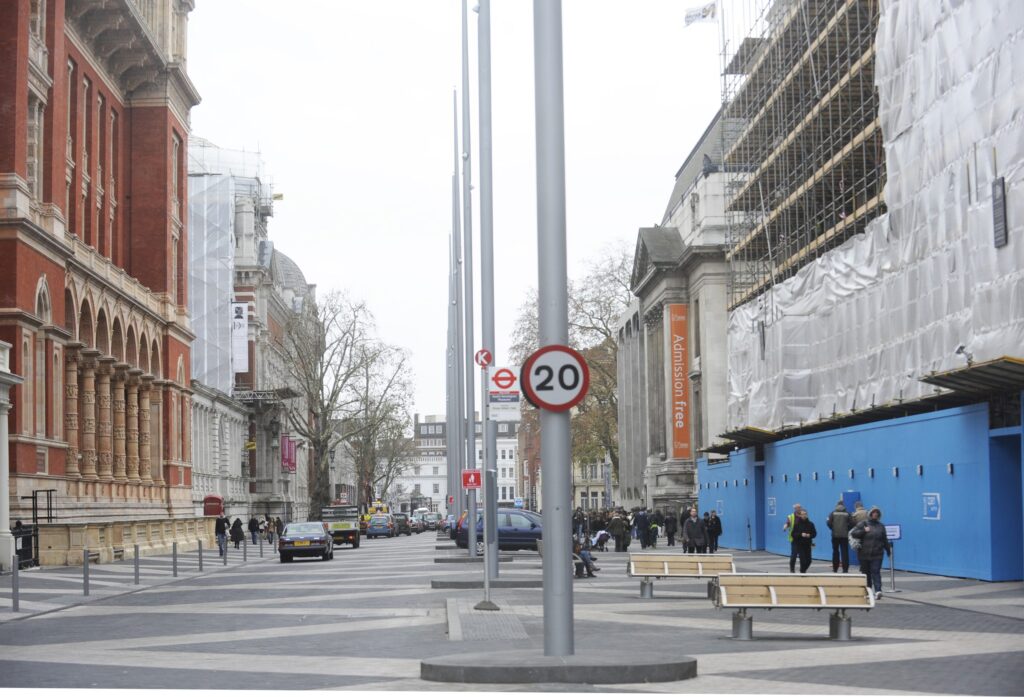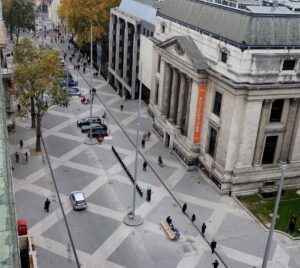Project officially opened by the Mayor of London this February
The spectacular transformation of London’s Exhibition Road was marked with an official opening this February, following the implementation of a £29M project taking eight years of planning.
The completion of the mixed use pedestrian and vehicle zone along the major South West London thoroughfare Exhibition Road, saw construction management specialist Schal deliver this landmark project on time and on budget. The company has been a key player in the capital’s highest profile street regeneration this decade, project managing a development which has radically changed the appearance of the quarter and which will shape the experience of its many millions of visitors that will come each year.The reconceived space runs the entire half-a-mile length of Exhibition Road, from Hyde Park in the north to South Kensington Underground Station in the South, offering easy access to London landmarks including The Royal Albert Hall, The Natural History Museum, the Science Museum, V&A Museum and Imperial College, London.
The new, single-level road surface does away with kerb stones and traditional street clutter such as pedestrian barriers, instead delivering a single “shared” space, divided into pedestrian, mixed use and drivers’ zones. The three zones are tied together by a repeated bold diamond motif in granite, which runs the entire length and width of the project, creating a unique visual identity for the street. Tall, sleek street lighting masts have been designed to complement the grand buildings of Exhibition Road. Black cast iron drainage channel covers run along each side, about four metres out from the respective building lines. Beside the drainage channels, strips of ‘corduroy’ tactile warn blind and partially sighted people that they are moving into or out of vehicle free areas.In July 2011 the ambitious scheme won the “Placemaking” category in the New London Awards, before it had even been completed.
In winter 2003, following on from the very sucessful Kensington High Street scheme, the Royal Borough held competitions to seek out the best designer and project manager for the more ambitious Exhibition Road project. The architects Dixon Jones were appointed as designer and Schal, the project management division of TPS Consult (part of Carillion plc), as project manager, in the summer of 2004. Schal also had responsibility for cost management and planning supervision (CDMC) with the cost management being sub-contracted to consultant Davis Langdon.
“The object of the Exhibition Road project was to make a world class pedestrian friendly environment” says Schal’s senior project manager,AndrewHousam. “A single surface concept, in which pedestrians and vehicles can co-exist.”
Schal’s role included:
- Supporting the client secure funding from Transport for London (TfL), the National Lottery and English Heritage.
- Liaising with all stakeholders including designers, contractors and regulatory bodies to develop a strategy for the delivery of the project.
- Developing a cost control system, that included electronic invoicing, which ensured the project remained within budget.
- Developing and enforcing site safety procedures.
- Mobilising and managing the start-up phase for the main works, including establishing site procedures.
- Managing a two year highway project in the middle of a busy central London thoroughfare, including the alteration of a one-way system around South Kensington Underground Station.
- Monitoring progress and avoiding time and cost over-runs.
- Handing the project back to the client on completion, on time and operational for the Olympics (a key project goal).
“We were able to help the client achieve the funding,” says Housam. “In the early phases of the project the client built up good relationships with TfL who provided initial funding which led to the major support the project needed. Our reputation, from Trafalgar Square, and plans gave funders confidence that the project would be achieved within budget and on time.“
“The whole concept of the single surface road, although not entirely new, has been taken to a new level in terms of extent and use of materials, he continues. “Our role in managing the design process has ensured the design innovation has been rigorous and cost effective. We managed the risk with the use of contractor design elements.”
Schal’s innovations included a phased approach which simplified the project and reduced the risks. The company developed openness and co-operation among the team, using an NEC option D Target cost contract with a pre-construction services contract to successfully manage the risks.
The project involved input and co-ordination with a number of major complex organisations. Schal’s approach was that each organisation appoint a single point of contact (SPOC) for the project to co-ordinate their organisation’s input.
“The client is appreciative that we finished the project on time and within budget and recognises that our advice, management, programme and cost control was a significant factor in achieving that outcome,” continues Schal Project Manager Wayne Solman. “As well as being within budget the works costs compares favourably with the initial estimate produced in 2004, well before the budget was set or the design developed.”
As well as radically improving the street-space, Solman believes the project has given businesses and organisations on Exhibition Road an incentive to refurbish their own frontages. “Since completion, a significant number of museums, residential properties and shops have carried out facade improvements,” he says. “The whole road is looking remarkably bright and new. The street improvements have given the whole area a lift and clearly demonstrates the significant mutiplier effect of urban infra stucture investment.”
The completion of works was marked with an opening event on 8th December, followed by an official opening attended by Mayor of London Boris Johnson this February. Mayor Johnson said: “Like the many other improvements we are making to London’s great outdoors it is projects like these that are not just creating fantastic new places to enjoy but which are supporting and delivering many jobs across the capital.”
Schal has been responsible for many similar projects, including the World Squares project in 2002, which saw this £20m project cover the environmental enhancement and consequent traffic management of Trafalgar Square and the surrounding area, and was intended to be the first implementation phase of Fosters and Partners World Squares for All Masterplan.



It’s good to see that a project which was first conceived back in the mid-nineties has at last become a reality.
Schal were involved as Project Manager and Construction Consultant when RBK&C led a consortium including all the museums, looking into opening up the space along Exhibition Way, and making use of LUL’s tunnel from South Kensington station.
Foster as Concept Designer were attempting to create a single-point access Hall below street level, with part-glazed pedestrian paving above, together with a vast glass-enclosed restaurant between the Science and Natural History Museums. Leibskin’s “spiral” extension to the V & A was also to be integrated into the scheme.
At the end of the day, support from the Heritage Lottery Fund dwindled and the project was mothballed for some years.